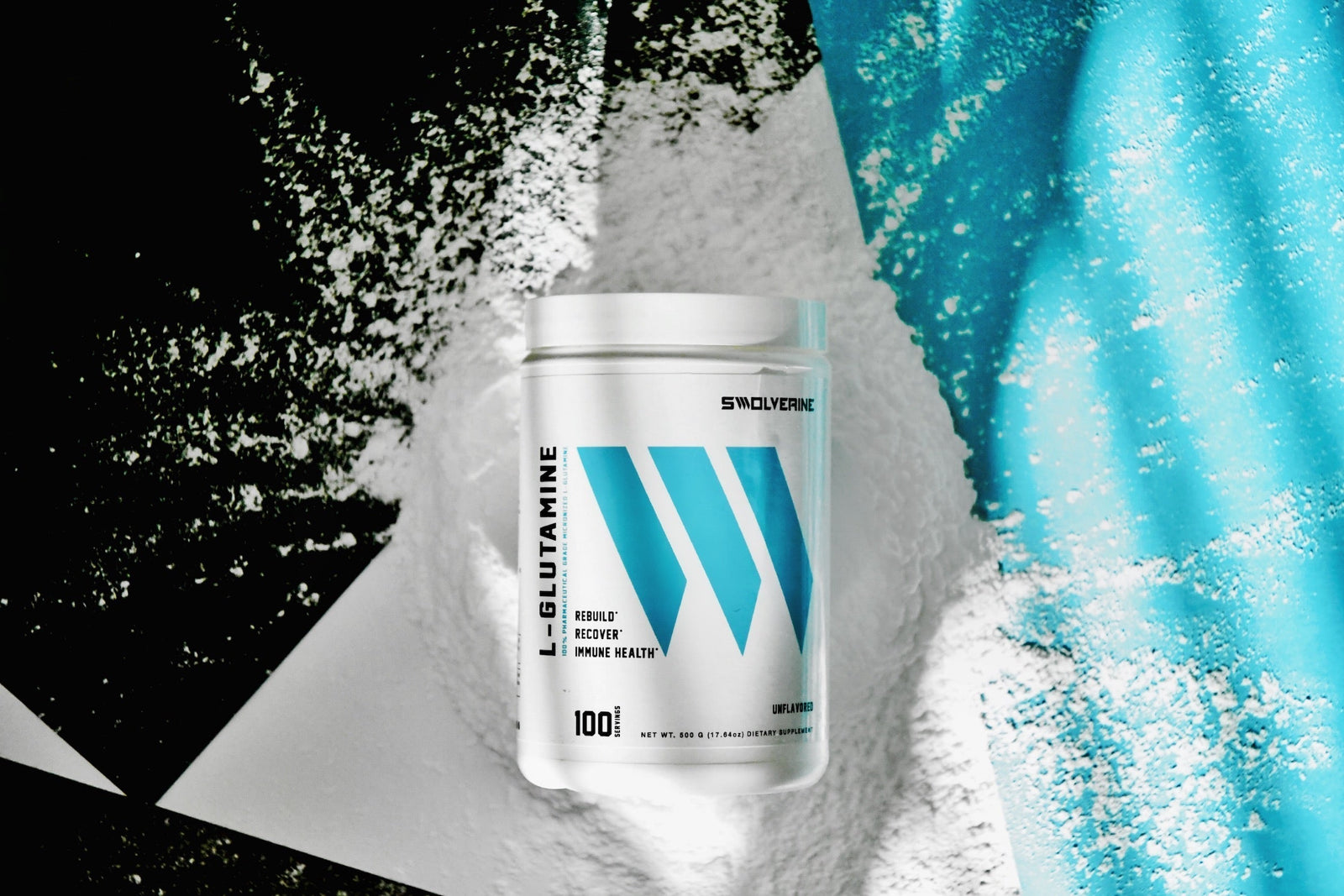When it comes to optimizing your training, enhancing recovery, and building lean muscle mass, two supplements stand out in nearly every athlete’s stack: glutamine and creatine. Both are amino acid-based compounds with distinct roles in the body—one known for its muscle-fueling power and the other for its recovery and gut-healing benefits.
But how exactly do they differ? Which one should you take—and when? Whether you're a strength athlete, endurance competitor, or just serious about results in the gym, understanding the difference between glutamine vs. creatine can help you tailor your supplementation strategy for peak performance, faster recovery, and better overall health.
In this guide, we’ll break down their functions, benefits, molecular structures, dosing protocols, and real-world applications, plus explore whether stacking them offers a performance edge backed by science.
What Is Glutamine and What Does It Do?
The Most Abundant Amino Acid in the Body
L-glutamine is the most abundant naturally occurring amino acid in the human body. It plays a vital role in muscle recovery, gut health, and immune system function. Its multifunctional capabilities make it a key nutrient for athletes, individuals under high stress, and those managing digestive or immune-related health issues.
What Does "Conditionally Essential" Mean?
Glutamine is classified as a conditionally essential amino acid. Under normal conditions, the body can synthesize enough glutamine to meet physiological needs. However, in situations involving physical stress, trauma, illness, or intense training, glutamine synthesis may not meet the body’s demand. In these cases, it becomes necessary to increase intake through glutamine-rich foods or supplementation to restore optimal levels (Harper et al., The Journal of Nutrition).
Prolonged workouts, endurance training, or high-intensity strength sessions can cause the body to rapidly deplete its glutamine stores. Without replenishment, this can negatively affect recovery, strength, stamina, and immune response. Supplementation supports the body's ability to recover faster and rebuild muscle more effectively.
Glutamine in Muscle and Brain Function
Glutamine comprises about 60% of the amino acid pool within skeletal muscle. Its ability to cross the blood-brain barrier gives it additional roles beyond muscular recovery. In the brain and body, glutamine contributes to:
-
Nitrogen transport between tissues
-
Regulation of acid-base balance
-
Gluconeogenesis (production of glucose from non-carbohydrate sources)
-
Serving as a precursor to nucleotide bases and the antioxidant glutathione (Castell et al., Nutrition)
These functions highlight the importance of maintaining adequate glutamine levels, especially when under metabolic stress or physical exertion.
Glutamine for Performance and Recovery
During exercise, especially endurance-based or high-volume training, the demand for glutamine increases significantly. As stores are depleted, the body may break down muscle protein to release glutamine for other critical functions. This leads to muscle catabolism, fatigue, and impaired recovery.
Post-workout glutamine supplementation has been shown to:
-
Decrease muscle breakdown
-
Enhance muscle protein synthesis
-
Shorten recovery time
-
Reduce delayed onset muscle soreness (DOMS) (Rohde et al., International Journal of Sport Nutrition and Exercise Metabolism)
These benefits make glutamine an effective tool for athletes seeking faster recovery, improved training consistency, and muscle preservation.
Glutamine and Gut Health
Beyond its athletic benefits, glutamine plays a crucial role in gut health. It is the primary energy source for enterocytes—the cells that line your intestines—and is essential in maintaining the structural integrity of the intestinal lining. Glutamine:
-
Supports the mucosal barrier of the gut
-
Reduces intestinal permeability ("leaky gut")
-
Fuels immune activity within the gut-associated lymphoid tissue (GALT)
This makes it a valuable therapeutic nutrient for people with gastrointestinal disorders such as inflammatory bowel disease (IBD), irritable bowel syndrome (IBS), Crohn’s disease, and ulcerative colitis. Research has demonstrated glutamine’s ability to improve symptoms associated with these conditions and help repair damaged intestinal tissue (Van Der Hulst et al., The Lancet).
Benefits of L-Glutamine
-
Reduces muscle mass breakdown
-
Initiates muscle protein synthesis
-
Improves post-exercise recovery time
-
Decreases muscle soreness
-
Supports immune system function
-
Promotes digestive and intestinal health
-
Helps reduce symptoms of IBD, IBS, and leaky gut
Related Reading
The Ultimate Guide to L-Glutamine
What Are the Benefits of L-Glutamine
How L-Glutamine Can Help Inflammatory Bowel Disease
What Is Creatine and What Does It Do?
One of the Most Researched Ergogenic Aids for Strength and Performance
Creatine is one of the most widely studied and effective ergogenic aids used to enhance power, strength, and athletic performance. Commonly taken as a supplement in the fitness and bodybuilding world, creatine has gained popularity for its ability to support short bursts of high-intensity exercise, improve recovery, and increase lean muscle mass.
What Is Creatine Made Of?
Creatine is naturally synthesized in the body from three amino acids: methionine, arginine, and glycine. It is produced primarily in the liver and kidneys, then transported and stored in skeletal muscle tissue, where about 95% of the body’s creatine is found.
Once inside the muscle, creatine is converted into phosphocreatine, which helps form adenosine triphosphate (ATP)—your body’s immediate and primary energy source. During explosive activities like sprinting or weightlifting, phosphocreatine rapidly donates phosphate groups to regenerate ATP, fueling muscular contractions and increasing power output (Buford et al., Journal of the International Society of Sports Nutrition).
Creatine’s Impact on Performance and Muscle Growth
Supplementing with creatine increases the total amount of stored phosphocreatine in the muscles. This allows for faster regeneration of ATP during high-intensity training, helping athletes:
-
Lift heavier weights
-
Perform more reps
-
Recover faster between sets
-
Experience enhanced gains in strength and lean muscle mass
Clinical studies confirm that creatine supplementation is associated with improved training performance, increased muscular hypertrophy, and greater improvements in strength and speed over time (Kreider et al., Journal of Strength and Conditioning Research).
Different Forms of Creatine
There are several types of creatine available on the market besides the traditional creatine monohydrate, including:
-
Creatine hydrochloride (HCL)
-
Creatine ethyl ester
-
Creatine nitrate
-
Kre-Alkalyn
While many of these forms are marketed as more advanced or better absorbed, research shows that most forms of creatine do not significantly differ in performance benefits compared to monohydrate—with one exception: Kre-Alkalyn (Cooper et al., Journal of the International Society of Sports Nutrition).
What Is Kre-Alkalyn?
Kre-Alkalyn is a pH-corrected form of creatine monohydrate. It was developed to solve some of the reported drawbacks of monohydrate supplementation, including:
-
Bloating
-
Cramping
-
Water retention
-
Conversion to creatinine (a byproduct associated with reduced absorption and potential digestive discomfort)
One of the key challenges with creatine monohydrate is that it typically requires a loading phase of 10–15 grams per day for up to 10 days to saturate the muscles and start yielding benefits. This means a user might need 100–150 grams of creatine before seeing noticeable effects.
Kre-Alkalyn, however, has improved bioavailability and does not require a loading phase. Because it is pH-buffered, it is more stable in the stomach and better absorbed by the body (Jagim et al., Nutrition Research).
Research Supporting Kre-Alkalyn
In a double-blind clinical study involving 24 elite athletes from the Bulgarian National Weightlifting Team, researchers compared the effects of Kre-Alkalyn to standard creatine monohydrate over a 60-day period. The results showed that the Kre-Alkalyn group experienced a 28.25% greater average increase in strength compared to the monohydrate group.
Additionally, Kre-Alkalyn users did not report adverse effects commonly associated with monohydrate, such as water retention or gastrointestinal discomfort (Stout et al., Journal of Applied Physiology).
Emerging evidence also shows that Kre-Alkalyn may help improve VO2 max and muscular endurance, making it a potential performance-enhancing supplement for both anaerobic and aerobic athletes.
Benefits of Creatine
-
Increases muscle mass and strength
-
Enhances training recovery
-
Improves speed and sprint performance
-
Supports cognitive and brain function
-
Improves endurance and VO2 max
-
Enhances overall athletic performance
Related Reading
What Are the Benefits of Kre-Alkalyn Creatine
Pros and Cons of Creatine Monohydrate
Kre-Alkalyn vs Creatine Monohydrate: Which One Is Better?
What’s the Difference Between Glutamine vs Creatine?
The Mechanism: How They Work
Creatine and glutamine serve distinctly different purposes in the body, especially when it comes to exercise performance and recovery.
Creatine works by increasing levels of adenosine triphosphate (ATP), the body’s primary energy molecule used during short, high-intensity efforts. By supplying more phosphocreatine to muscles, creatine enhances performance during explosive movements like sprinting, weightlifting, and HIIT-style training (Buford et al., Journal of the International Society of Sports Nutrition).
In contrast, glutamine plays a major role in nitrogen transport, which influences muscle protein breakdown, immune health, and gut repair. Glutamine supports muscle recovery by helping the body distribute nitrogen atoms effectively, which is necessary for rebuilding damaged muscle tissue and maintaining a positive nitrogen balance. Additionally, glutamine plays a key role in supporting the intestinal lining and protecting the gut from bacteria and pathogens (Castell et al., Nutrition).
Molecular Structure
Both creatine and glutamine are amino acid-based compounds, but their structures differ significantly.
-
Glutamine is a single conditionally essential amino acid, meaning the body can produce it under normal conditions but may require supplementation during periods of physical or metabolic stress.
-
Creatine, on the other hand, is synthesized from three amino acids:
-
Arginine (conditionally essential)
-
Glycine (conditionally essential)
-
Methionine (essential)
-
Creatine is formed in the liver and kidneys, while glutamine is produced mostly in skeletal muscle, where it also plays a key role in immune regulation and recovery.
Performance Benefits
Glutamine and creatine offer unique performance benefits based on how they function in the body.
-
Glutamine: Primarily used for muscle recovery, reducing delayed onset muscle soreness (DOMS), and enhancing immune support. It helps reduce muscle catabolism and supports muscle protein synthesis by maintaining nitrogen balance.
-
Creatine: Supports explosive strength, power output, and short-duration anaerobic performance. It increases phosphocreatine stores, which allows for faster regeneration of ATP during repeated bouts of intense training (Kreider et al., Journal of Strength and Conditioning Research).
In a study conducted at Auburn University, researchers examined the effects of creatine and glutamine supplementation over 8 weeks on body composition and performance outcomes in 29 collegiate track and field athletes. Participants were randomized into three groups: creatine, creatine + glutamine, and placebo. All groups completed the same periodized strength training program. The study found that stacking creatine with glutamine significantly increased lean body mass and peak power output during repeated high-intensity cycling bouts (Schilling et al., Journal of Strength and Conditioning Research).
Both Are Abundant in Animal Proteins
Creatine and glutamine are naturally found in animal-based protein sources.
-
Glutamine-rich foods: Beef, chicken, turkey, fish, and dairy products
-
Creatine-rich foods: Herring, tuna, pork, bison, beef, and salmon
Although these amino acids can be obtained through whole foods, dietary sources alone are not sufficient to yield the levels required for noticeable improvements in training performance or recovery. Supplementation is often necessary to experience the ergogenic effects.

What’s the Recommended Dose of Glutamine and Creatine?
To achieve measurable performance and health benefits, proper dosing of both glutamine and creatine is essential.
-
Glutamine:
-
5 grams daily to support muscle recovery and immune function
-
15–20 grams daily for digestive health and gut repair
-
-
Creatine Monohydrate:
-
10–15 grams daily for the first 5–10 days (loading phase)
-
5 grams daily for maintenance thereafter
-
Total intramuscular creatine and phosphocreatine levels can increase by 15–40%, leading to greater anaerobic capacity and power output (Greenwood et al., Journal of Exercise Physiology)
-
-
Kre-Alkalyn Creatine:
-
3 grams daily, no loading phase required
-
Due to its pH-buffered nature, Kre-Alkalyn offers better absorption, stability, and bioavailability, reducing potential side effects like bloating and water retention (Jagim et al., Nutrition Research)
-
Glutamine vs Creatine: Which One—or Both?
When comparing glutamine vs creatine, the choice comes down to your goals—but for most athletes, the best option isn’t choosing one over the other. It’s using both.
Creatine is unmatched for increasing strength, explosive power, and muscle fullness during high-intensity training. Glutamine, on the other hand, supports post-workout recovery, helps prevent muscle breakdown, and strengthens the gut and immune system—especially under stress.
Together, they form a powerful, science-backed stack that supports performance from multiple angles: energy production, muscle growth, recovery, and overall health. If you’re serious about maximizing results, supplementing with both glutamine and creatine could be the edge you’ve been looking for.
Find similar articles:
Supplements






